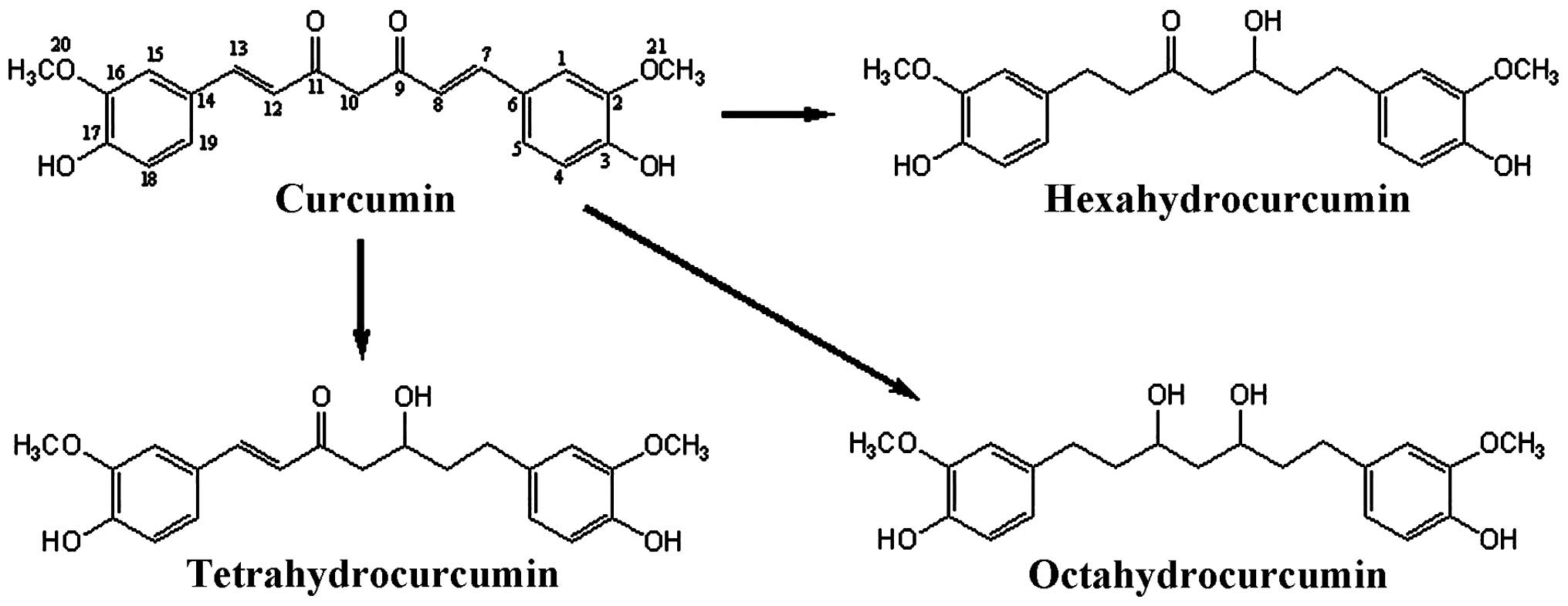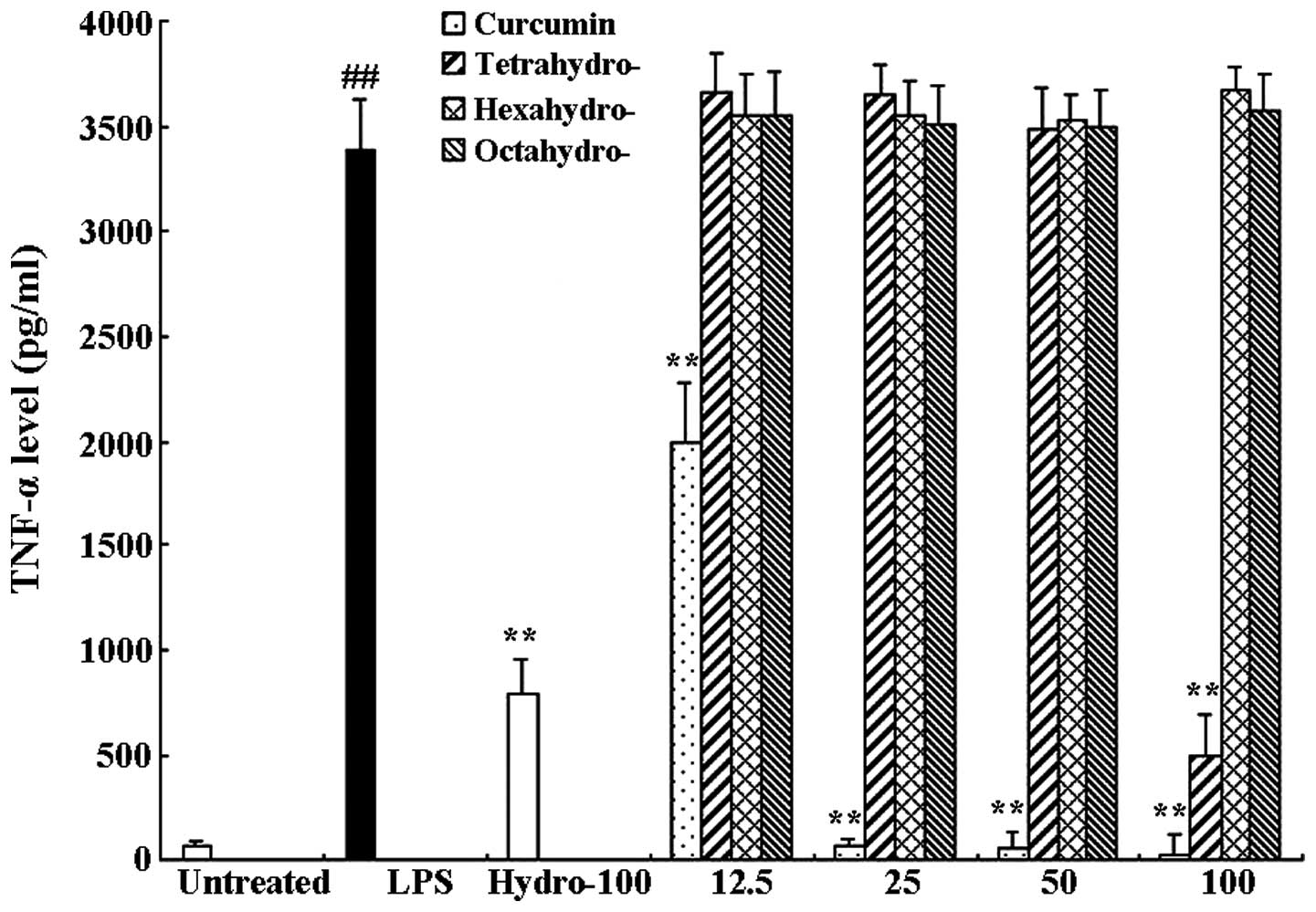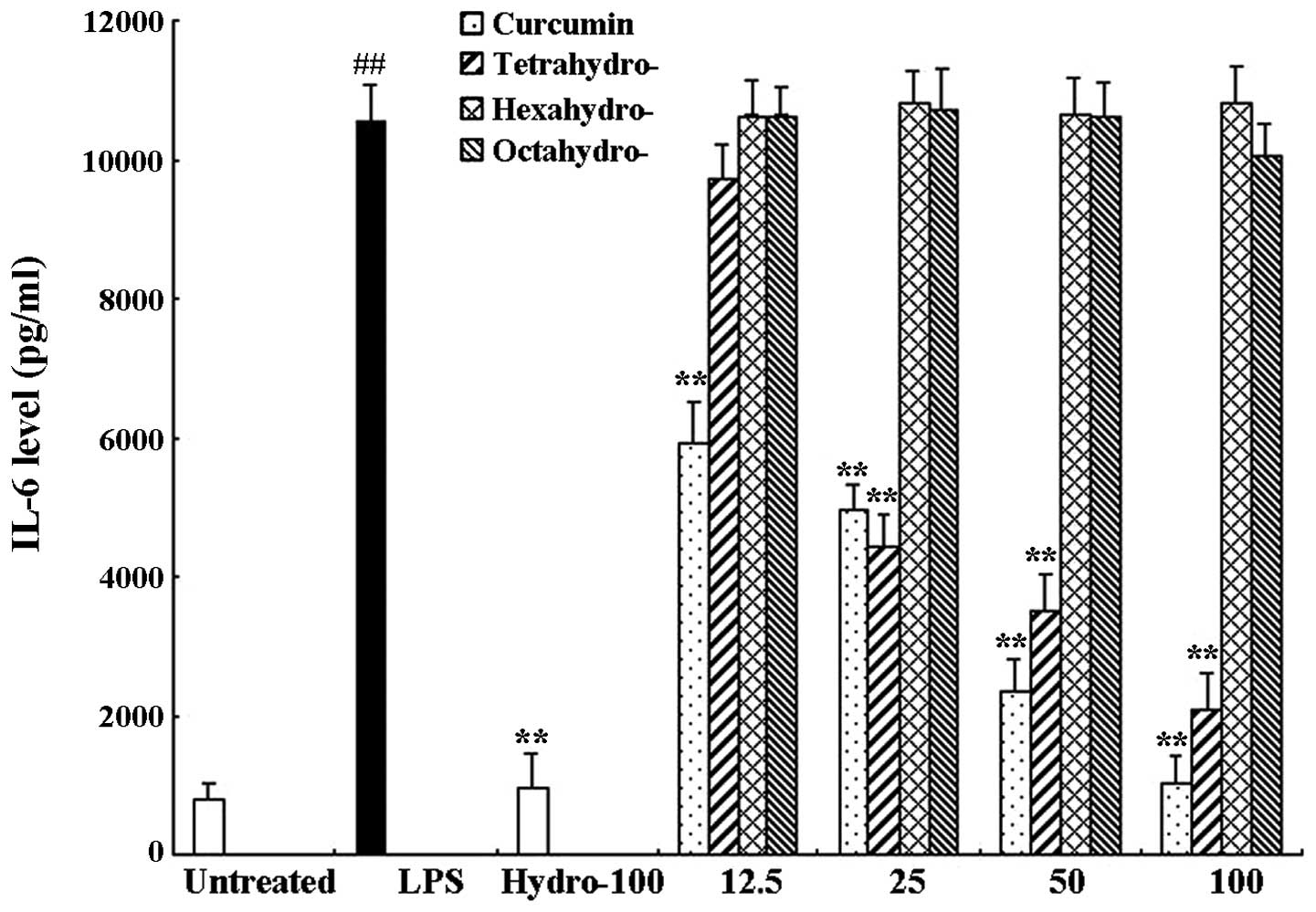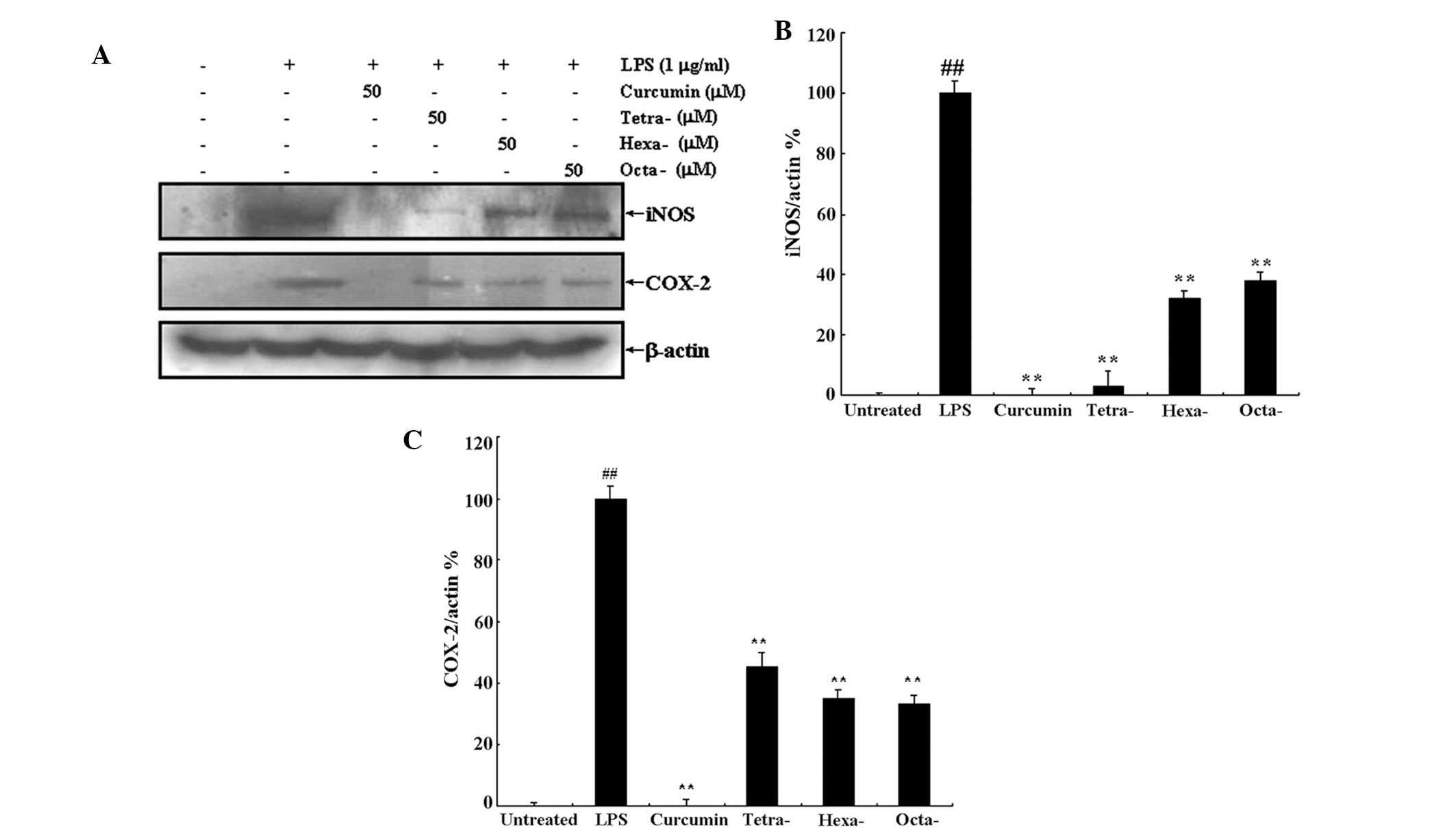Curcumin and its major metabolites inhibit the inflammatory response induced by lipopolysaccharide: Translocation of nuclear factor-κB as potential target
- Authors:
- Published online on: December 11, 2014 https://doi.org/10.3892/mmr.2014.3079
- Pages: 3087-3093
Abstract
Introduction
Previous studies have reported that curcumin exhibited a wide spectrum of biological activities, including anti-inflammatory (1,2), anti-tumor (3–6), antioxidant (7,8), anti-microbial (9,10), choleretic (11), neuroprotective (12,13) and anti-mutagenic (14) activities; curcumin was also found to be involved in numerous drug-drug interactions (15,16). Evidence suggested that curcumin was markedly efficacious and safe at high doses (17,18); however, due to low absorption and rapid metabolism, the bioavailability of curcumin was not ideal (19). Previous studies on the pharmacokinetics of curcumin led to the identification of key metabolites, including tetrahydrocurcumin, curcumin-O-glucuronide, curcumin-O-sulfate, hexacurcumin, monoacetylcurcumin and octahydrocucumin (20), of which tetrahydrocurcumin was characterized as the primary metabolite and has been widely investigated for its biological activities.
Tetrahydrocurcumin was reported to induce autophagic cell death through coordinated modulation of the phosphoinositide 3-kinase/Akt-mechanistic target of rapamycin and mitogen-activated protein kinase signaling pathways in human leukemia HL-60 cells (21). Tetrahydrocurcumin was reported to reduce HT1080-cell invasion and migration via downregulation of extracellular matrix (ECM)-degrading enzymes and inhibition of cell adhesion to ECM proteins (22). The anti-cancer and anti-angiogenic effects of curcumin and tetrahydrocurcumin were also demonstrated in implanted hepatocellular carcinoma in nude mice (23). Furthermore, tetrahydrocurcumin was shown to be more effective than curcumin in preventing azoxymethane-induced colon carcinogenesis (24).
However, previous studies on the anti-inflammatory effect of tetrahydrocurcumin and the biological activities of other curcumin metabolites are limited (25). One of these studies identified metabolites of curcuminoids in the feces and urine of rats following oral administration (26). The aim of the present study was to investigate and compare the anti-inflammatory activities of curcumin and its three metabolites, tetrahydrocurcumin, hexahydrocurcumin and octahydrocurcumin in lipopolysaccharide (LPS)-stimulated RAW 264.7 macrophage cells. Chemical structures of curcumin and its three metabolites are shown in Fig. 1.
Materials and methods
Curcumin and its metabolites
A mixture of curcuminoids (curcumin, 55.2%; demethoxycurcumin, 22.9%; and bisdemethoxycurcumin, 21.8%) was purchased from Tianjin Jian Feng Pharmaceutical Co., Ltd (Tianjin, China). Male Wistar-derived rats (200–250 g body weight, 8–10 weeks old, provided by the Laboratory Animal Center of the Shenyang Pharmaceutical University, Shenyang, China) were housed under controlled temperature (22±2°C), humidity (55±10%) and light (8:00 a.m. to 8:00 p.m.) conditions in a breeding room. Normal food and water were available ad libitum but were withdrawn 24 h prior to administration. Curcuminoids were administered per os as a 30% aqueous 1,2-propylene glycol solution. Urine and feces were collected for 48 h from the animals housed in stainless steel metabolism cages equipped with a urine and feces separator (B6–10, Suhang Technology Equipment Co., Ltd., Suzhou, China). Animal experiments were performed in accordance with the Guide for the Care and Use of Laboratory Animals of the Shenyang Pharmaceutical University (approval date: 08/10/2010, no. 100810; Liaoning, China). Tetrahydrocurcumin, hexahydrocurcumin and octahydrocurcumin (Fig. 1) were isolated from feces and urine of rats over 48 h following oral administration of the curcuminoid mixture, as previously described (26). The purity of tetrahydrocurcumin, hexahydrocurcumin and octahydrocurcumin was determined using high-performance liquid chromatography (HPLC; Waters 600; Waters Corp., Milford, MA, USA) and a ultraviolet detector (Waters 490; Waters Corp.); peak areas were normalized and the purities of the metabolites were 98.2, 98.6 and 98.5%, respectively.
Reagents
RPMI 1640 medium and fetal bovine serum (FBS) were obtained from Invitrogen Life Technologies (Carlsbad, CA, USA). Mouse tumor necrosis factor-α (TNF-α) and interleukin-6 (IL-6) ELISA kits as well as a bicinchoninic acid (BCA) protein concentration assay kit were obtained from Yantai Science and Biotechnology Co., Ltd (Shandong, China). Anti-NOS2 antibody (sc-651, rabbit polyclonal IgG, dilution 1:1,000), anti-Cox-2 antibody (sc-1746, goat polyclonal IgG, dilution 1:1,000), anti-IκB-α antibody (sc-371, rabbit polyclonal IgG, dilution 1:1,000), anti-NFκB p65 antibody (sc-372, rabbit polyclonal IgG, dilution 1:1,000) and anti-actin antibody (sc-1616, goat polyclonal IgG, dilution 1:1,000), as well as horseradish peroxidase (HRP)-conjugated secondary antibodies were purchased from Santa Cruz Biotechnology, Inc. (Dallas, TX, USA). Phenylmethylsulfonyl fluoride, dithiothreitol, E. coli, LPS and all other chemicals used in the present study were purchased from Sigma-Aldrich (St. Louis, MO, USA). A 50 mM solution of tested samples was prepared in 100% cell culture grade dimethyl sulfoxide, stored as small aliquots at −20°C, and then diluted to the required concentrations prior to use. Hydrocortisone (H4001; purity, ≥98%; Sigma-Aldrich) was used as the positive control drug for all experiments performed.
Cell culture
Mouse monocyte-macrophage RAW 264.7 cells (TIB-71; American Type Culture Collection, Manassas, VA, USA) were maintained in RPMI 1640 medium supplemented with penicillin (100 U/ml; Yantai Science and Biotechnology Co., Ltd.), streptomycin (100 μg/ml; Yantai Science and Biotechnology Co., Ltd.) and 10% heat-inactivated FBS at 37°C in a humidified incubator with 5% CO2 and 95% air. Medium was routinely replaced every two days and cells were passaged using 0.25% trypsin (Yantai Science and Biotechnology Co., Ltd.) until they attained confluence.
Nitric oxide (NO) analysis
The amount of nitrite in the cell culture supernatant was determined using a commercial Griess reagent kit (a mixture of Griess reagent A and Griess reagent B, ratio 1:1, A: 1% sulphanilamide in 5% H3PO4 and B: 0.1% naphthylethylene diamine dihydrochloride) (Yantai Science and Biotechnology, Co., Ltd.) as previously described (27). RAW 264.7 cells were treated with LPS (1 μg/ml) and curcumin or its respective metabolites (12.5–100 μM) for 24 h. Cell culture supernatant (100 μl) was added to 100 μl Griess reagent and then incubated at room temperature for 10 min. Absorbance was measured at 540 nm (Biotek Synergy HT; BioTek Instruments, Inc., Winooski, VT, USA) and inhibitory rates were calculated using a standard calibration curve of different concentrations of sodium nitrite as previously prepared (28).
Determination of cytokines, TNF-α and IL-6 expression
RAW 264.7 cells were treated with LPS (1 μg/ml) and curcumin or its respective metabolites (12.5–100 μM) for 6 h. Mouse tumor necrosis factor-α (TNF-α) and interleukin-6 (IL-6) ELISA kits (Yantai Science and Biotechnology Co., Ltd.) were used according to the manufacturer’s instructions in order to determine the protein expression levels of TNF-α or IL-6 using 100 μl culture supernatant as previously described (29).
Total protein, cytoplasmic and nuclear protein extraction
Total protein was extracted by using western cell lysis buffer (Yantai Science and Biotechnology Co., Ltd.) in order to determine the protein expression levels of iNOS and COX-2. Cytoplasmic and nuclear proteins were separated using a nuclear and cytoplasmic protein extraction kit according to the manufacturer’s instructions (Yantai Science and Biotechnology Co., Ltd.) for further use for the western blot analysis of IκB-α and nuclear factor kappa B (NF-κB) p65 subunit (30).
Western blot analysis
Protein concentrations were determined using a BCA protein concentration assay kit (Yantai Science and Biotechnology Co., Ltd.). Each respective protein (30 μg) was boiled in SDS-PAGE loading buffer (Yantai Science and Biotechnology Co., Ltd.), subjected to gel electrophoresis and then electrophoretically transferred onto nitrocellulose membranes (Pall Corporation, Port Washington, NY, USA). The membranes were blocked using 5% nonfat dried milk in Tris-buffered saline with Tween 20 (TBST; 20 mM Tris-HCl, 150 mM NaCl and 0.05% Tween 20) at room temperature for 1 h. Samples were then washed and incubated in their respective primary antibody solution (anti-iNOS, anti-COX-2, anti-IκB-α, anti-p65 or anti-β-actin, dilution 1:1,000) overnight at 4°C. Membranes were then washed with TBST and incubated with HRP-conjugated secondary antibody solution for 1 h at room temperature. Blots were then washed three times in TBST, detected using enhanced chemiluminescence (Beyotime Institute of Biotechnology, Haimen, China) and exposed to photographic films (Kodak, Tokyo, Japan). Images were collected and the corresponding protein bands for iNOS, COX-2, IκB-α, p65 and β-actin were quantified by densitometric analysis using DigDoc100 software (Alpha Innotech Corporation, San Leandro, CA, USA).). β-actin was used as the internal control.
Statistical analysis
Data were analyzed using SPSS 13.0 (SPSS, Inc., Chicago, IL, USA). Values are expressed as the mean ± standard deviation. Statistical comparisons were conducted using a one-way or two-way analysis of variance followed by a two-way post hoc test. P<0.05 was considered to indicate a statistically significant difference between values.
Results
Curcumin and its metabolites do not affect cell viability
A preliminary MTT assay showed that curcumin and its metabolites (3.125–100 μM) did not affect the viability of RAW 264.7 cells within 24 h.
Curcumin and its metabolites inhibit LPS-induced NO overproduction in RAW 264.7 cells
RAW 264.7 cells were treated with 1 μg/ml of LPS only or in combination with different concentrations of curcumin and its metabolites or hydrocortisone as the positive control. The concentration of nitrite was determined by detecting NO production levels 24 h following treatment (Fig. 2). LPS induced a significant increase in nitrite concentration compared with that of the untreated group (P<0.01; 34.78±2.54 and 3.96±0.29 μM, respectively). In addition, curcumin and its three metabolites significantly inhibited the LPS-induced NO overproduction in a dose-dependent manner (P<0.01); however, curcumin exhibited a more potent inhibition of nitrate concentrations compared to that of its metabolites.
Curcumin and tetrahydrocurcumin significantly inhibit the release of TNF-α and IL-6 in RAW 264.7 cells
RAW 264.7 cells were treated with 1 μg/ml LPS only or in combination with different concentrations of curcmin and its metabolites or hydrocortisone as the positive control. Following 6 h of incubation, an ELISA assay was used to determine the levels of TNF-α and IL-6 in the supernatants. As shown in Figs. 3 and 4, compared to the untreated control group, LPS significantly induced the release of proinflammatory cytokines TNF-α (63.57±6.41 and 3389.97±39.11 pg/ml, respectively) and IL-6 (811.95±32.84 and 10536.81±833.99 pg/ml, respectively). Curcumin exerted a significant inhibitory effect on TNF-α as well as IL-6 release compared to that of the LPS-only group; LPS-induced TNF-α and IL-6 release were almost completely inhibited following 100 μM curcumin treatment. In addition, the curcumin metabolite tetrahydrocurcumin significantly inhibited the release of TNF-α and IL-6, whereas hexahydrocurcumin and octahydrocurcumin did not exhibit any marked inhibitory effects on the release of TNF-α and IL-6 at concentrations of 12.5–100 μM.
Curcumin and its metabolites inhibit LPS-induced iNOS and COX-2 overexpression
As demonstrated above, curcumin and its metabolites were able to inhibit LPS-induced NO overproduction (Fig. 2). NO overproduction is associated with the upregulation of iNOS expression; therefore, in the present study, western blot analysis was used to determine the expression levels of iNOS and COX-2 following treatment with LPS in the presence or absence of 50 μM curcumin or its metabolites (Fig. 5A). Densitometric analysis revealed that 50 μM curcumin completely inhibited LPS-induced expression of iNOS and COX-2 (Fig. 5B and C, respectively); in addition, curcumin metabolites significantly inhibited iNOS and COX-2 expression compared to that of the LPS only treatment. Furthermore, the metabolite tertrahydrocurcumin appeared to exhibit a more potent effect on iNOS expression compared to that of the other metabolites; however, statistical analyses were not performed to confirm this observation.
Curcumin and its metabolites prevent the translocation of NF-κB to the nucleus via inhibition of LPS-induced IκB-α protein degradation
Translocation of NF-κB to the nucleus is the result of IκB-α protein degradation. Western blot analysis was used to determine the effect of curcumin and its metabolites on LPS-induced IκB-α degradation and translocation of NF-κB to the nucleus. As shown in Figs. 6 and 7, treatment with 50 μM curcumin or its metabolites significantly inhibited the LPS-induced decrease in cytoplasmic IκB-α expression as well as the LPS-induced increase in nuclear protein expression of the NF-κB subunit p65. This therefore indicated that curcumin and its metabolites inhibited IκB-α degradation and, as a result, prevented the translocation of NF-κB to the nucleus. Futhermore, the three metabolites of curcumin produced significant results; however, they appeared to have a less potent effect on LPS-induced degradation of IκB-α and p65 expression than that of curcumin.
Discussion
Elucidation of metabolite structures is among the most challenging tasks of drug metabolism studies. At present, comparisons of electrospray ionization multi-stage tandem mass spectrometry data and HPLC retention times with synthetic standards are generally used to identify the structures of metabolites (31). However, when metabolites are difficult to obtain or synthesize, biological studies into the activities of these drug metabolites may be challenging or even impossible.
In the present study, the anti-inflammatory activities of three major metabolites of curcumin were investigated and compared to those of curcumin. Among these metabolites, tetrahydrocurcumin was previously reported to be the primary metabolite of curcumin and has been investigated for its biological activities (21–23); however, these studies primarily focused on the anti-tumor activities of tetrahydrocurcumin, whereas studies into the other metabolites of curcumin and their numerous biological activities are rare and insufficient. The results of the present study indicated that three major metabolites of curcumin, including tetrahydrocurcumin, hexahydrocurcumin and octahydrocurcumin (25), inhibited various LPS-induced responses of RAW 264.7 macrophage cells, including excess NO production, increased iNOS and COX-2 protein expression as well as LPS-induced degradation of IκB-α and overexpression of nuclear p65; in addition, tetrahydrocurcumin significantly inhibited the LPS-induced release of pro-inflammatory cytokines TNF-α and IL-6. However, the results also determined that curcumin exerted more potent inhibitory effects on the LPS-induced responses of RAW 264.7 cells.
In conclusion, the results of the present study confirmed the anti-inflammatory effects of curcumin and its metabolites in RAW 264.7 macrophage cells and, to the best of our knowledge, the present study was the first direct study to compare the anti-inflammatory activities of curcumin and its main metabolites. In addition, the results indicated that the anti-inflammatory mechanism of curcumin and its metabolites may proceed via the inhibition of IκB-α degradation, which in turn prevented the translocation of NF-κB to the nucleus. These results may therefore provide the theoretical basis for further studies into the pharmacokinetics of curcuminoids.
Acknowledgements
The present study was supported by the Taishan Scholar Project to Fenghua Fu (Shangdong, China) and the Undergraduate Scientific and Technological Innovation Project of Yantai University (grant no. 131407; Shangdong, China).
References
|
Nandal S, Dhir A, Kuhad A, Sharma S and Chopra K: Curcumin potentiates the anti-inflammatory activity of cyclooxygenase inhibitors in the cotton pellet granuloma pouch model. Methods Find Exp Clin Pharmacol. 31:89–93. 2009. View Article : Google Scholar : PubMed/NCBI | |
|
Adapala N and Chan MM: Long-term use of an antiinflammatory, curcumin, suppressed type 1 immunity and exacerbated visceral leishmaniasis in a chronic experimental model. Lab Invest. 88:1329–1339. 2008. View Article : Google Scholar : PubMed/NCBI | |
|
Tian F, Fan T, Zhang Y, Jiang Y and Zhang X: Curcumin potentiates the antitumor effects of 5-FU in treatment of esophageal squamous carcinoma cells through downregulating the activation of NF-κB signaling pathway in vitro and in vivo. Acta Biochim Biophys Sin (Shanghai). 44:847–855. 2012. View Article : Google Scholar | |
|
Wang K, Zhang T, Liu L, Wang X, Wu P, Chen Z, Ni C, Zhang J, Hu F and Huang J: Novel micelle formulation of curcumin for enhancing antitumor activity and inhibiting colorectal cancer stem cells. Int J Nanomedicine. 7:4487–4497. 2012.PubMed/NCBI | |
|
Sadzuka Y, Nagamine M, Toyooka T, Ibuki Y and Sonobe T: Beneficial effects of curcumin on antitumor activity and adverse reactions of doxorubicin. Int J Pharm. 432:42–49. 2012. View Article : Google Scholar : PubMed/NCBI | |
|
Wang H, Geng QR, Wang L and Lu Y: Curcumin potentiates antitumor activity of L-asparaginase via inhibition of the AKT signaling pathway in acute lymphoblastic leukemia. Leuk Lymphoma. 53:1376–1382. 2012. View Article : Google Scholar | |
|
Aftab N and Vieira A: Antioxidant activities of curcumin and combinations of this curcuminoid with other phytochemicals. Phytother Res. 24:500–502. 2010. | |
|
Masuda T, Hidaka K, Shinohara A, Maekawa T, Takeda Y and Yamaguchi H: Chemical studies on antioxidant mechanism of curcuminoid: analysis of radical reaction products from curcumin. J Agric Food Chem. 47:71–77. 1999. View Article : Google Scholar : PubMed/NCBI | |
|
Jordan WC and Drew CR: Curcumin - a natural herb with anti-HIV activity. J Natl Med Assoc. 88:3331996. | |
|
Kim MK, Choi GJ and Lee HS: Fungicidal property of Curcuma longa L. rhizome-derived curcumin against phytopathogenic fungi in a greenhouse. J Agric Food Chem. 51:1578–1581. 2003. View Article : Google Scholar : PubMed/NCBI | |
|
Deters M, Siegers C, Muhl P and Hänsel W: Choleretic effects of curcuminoids on an acute cyclosporin-induced cholestasis in the rat. Planta Med. 65:610–613. 1999. View Article : Google Scholar : PubMed/NCBI | |
|
Liu H, Li Z, Qiu D, Gu Q, Lei Q and Mao L: The inhibitory effects of different curcuminoids on β-amyloid protein, β-amyloid precursor protein and β-site amyloid precursor protein cleaving enzyme 1 in swAPP HEK293 cells. Neurosci Lett. 485:83–88. 2010. View Article : Google Scholar : PubMed/NCBI | |
|
Zhao J, Zhao Y, Zheng W, Lu Y, Feng G and Yu S: Neuroprotective effect of curcumin on transient focal cerebral ischemia in rats. Brain Res. 1229:224–232. 2008. View Article : Google Scholar : PubMed/NCBI | |
|
Shukla Y, Arora A and Taneja P: Antimutagenic potential of curcumin on chromosomal aberrations in Wistar rats. Mutat Res. 515:197–202. 2002. View Article : Google Scholar : PubMed/NCBI | |
|
Volak LP, Ghirmai S, Cashman JR and Court MH: Curcuminoids inhibit multiple human cytochromes P450, UDP-glucuronosyltransferase, and sulfotransferase enzymes, whereas piperine is a relatively selective CYP3A4 inhibitor. Drug Metab Dispos. 36:1594–1605. 2008. View Article : Google Scholar : PubMed/NCBI | |
|
Graber-Maier A, Büter KB, Aeschlimann J, Bittel C, Kreuter M, Drewe J and Gutmann H: Effects of Curcuma extracts and curcuminoids on expression of P-glycoprotein and cytochrome P450 3A4 in the intestinal cell culture model LS180. Planta Med. 76:1866–1870. 2010. View Article : Google Scholar : PubMed/NCBI | |
|
Lao CD, Ruffin MT IV, Normolle D, Heath DD, Murray SI, Bailey JM, Boggs ME, Crowell J, Rock CL and Brenner DE: Dose escalation of a curcuminoid formulation. BMC Complement Altern Med. 6:102006. View Article : Google Scholar : PubMed/NCBI | |
|
Cheng AL, Hsu CH, Lin JK, et al: Phase I clinical trial of curcumin, a chemopreventive agent, in patients with high-risk or pre-malignant lesions. Anticancer Res. 21:2895–2900. 2001.PubMed/NCBI | |
|
Anand P, Kunnumakkara AB, Newman RA and Aggarwal BB: Bioavailability of curcumin: problems and promises. Mol Pharm. 4:807–818. 2007. View Article : Google Scholar : PubMed/NCBI | |
|
Zhongfa L, Chiu M, Wang J, Chen W, Yen W, Fan-Havard P, Yee LD and Chan KK: Enhancement of curcumin oral absorption and pharmacokinetics of curcuminoids and curcumin metabolites in mice. Cancer Chemother Pharmacol. 69:679–689. 2012. View Article : Google Scholar : | |
|
Wu JC, Lai CS, Badmaev V, Nagabhushanam K, Ho CT and Pan MH: Tetrahydrocurcumin, a major metabolite of curcumin, induced autophagic cell death through coordinative modulation of PI3K/Akt-mTOR and MAPK signaling pathways in human leukemia HL-60 cells. Mol Nutr Food Res. 55:1646–1654. 2011. View Article : Google Scholar : PubMed/NCBI | |
|
Yodkeeree S, Garbisa S and Limtrakul P: Tetrahydrocurcumin inhibits HT1080 cell migration and invasion via downregulation of MMPs and uPA. Acta Pharmacol Sin. 29:853–860. 2008. View Article : Google Scholar : PubMed/NCBI | |
|
Yoysungnoen P, Wirachwong P, Changtam C, Suksamrarn A and Patumraj S: Anti-cancer and anti-angiogenic effects of curcumin and tetrahydrocurcumin on implanted hepatocellular carcinoma in nude mice. World J Gastroenterol. 14:2003–2009. 2008. View Article : Google Scholar : PubMed/NCBI | |
|
Lai CS, Wu JC, Yu SF, Badmaev V, Nagabhushanam K, Ho CT and Pan MH: Tetrahydrocurcumin is more effective than curcumin in preventing azoxymethane-induced colon carcinogenesis. Mol Nutr Food Res. 55:1819–1828. 2011. View Article : Google Scholar : PubMed/NCBI | |
|
Pan MH, Lin-Shiau SY and Lin JK: Comparative studies on the suppression of nitric oxide synthase by curcumin and its hydrogenated metabolites through down-regulation of IkappaB kinase and NFkappaB activation in macrophages. Biochem Pharmacol. 60:1665–1676. 2000. View Article : Google Scholar : PubMed/NCBI | |
|
Li J, Liu Y, Wei JQ, Wang K, Chen LX, Yao XS and Qiu F: Isolation and identification of phase 1 metabolites of curcuminoids in rats. Planta Med. 78:1351–1356. 2012. View Article : Google Scholar : PubMed/NCBI | |
|
Zhao F, Wang L and Liu K: In vitro anti-inflammatory effects of arctigenin, a lignan from Arctium lappa L., through inhibition on iNOS pathway. J Ethnopharmacol. 122:457–462. 2009. View Article : Google Scholar : PubMed/NCBI | |
|
Ishihara T, Kohno K, Ushio S, Iwaki K, Ikeda M and Kurimoto M: Tryptanthrin inhibits nitric oxide and prostaglandin E(2) synthesis by murine macrophages. Eur J Pharmacol. 407:197–204. 2000. View Article : Google Scholar : PubMed/NCBI | |
|
Zhao F, Gao Z, Jiao W, Chen L, Chen L and Yao X: In vitro anti-inflammatory effects of beta-carboline alkaloids, isolated from Picrasma quassioides, through inhibition of the iNOS pathway. Planta Med. 78:1906–1911. 2012. View Article : Google Scholar : PubMed/NCBI | |
|
Zhao F, Chen L, Zhang M, Bi C, Li L, Zhang Q, Shi C, Li M, Zhou S and Kong L: Inhibition of lipopolysaccharide-induced iNOS and COX-2 expression by indole alkaloid, 3-(hydroxymethyl)-6,7-dihydroindolo[2,3-a]quinolizin-(12H)-one, via NF-κB inactivation in RAW 264.7 macrophages. Planta Med. 79:782–787. 2013. View Article : Google Scholar : PubMed/NCBI | |
|
Pursley J, Shen JX, Schuster A, Dang OT, Lehman J, Buonarati MH, Song Y, Aubry AF and Arnold ME: LC-MS/MS determination of apixaban (BMS-562247) and its major metabolite in human plasma: an application of polarity switching and monolithic HPLC column. Bioanalysis. 6:2071–2082. 2014. View Article : Google Scholar : PubMed/NCBI |
















